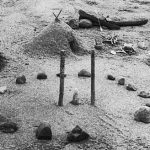 Mysteries
Mysteries  Mysteries
Mysteries  History
History 10 Surprising Stories About the Texas Rangers
 Humans
Humans 10 Philosophers Who Were Driven Mad by Their Own Theories
 Miscellaneous
Miscellaneous 10 Video-Game-Worthy Weapons and Armors from History
 Weird Stuff
Weird Stuff 10 Psychics Who Accurately Predicted Wartime Events
 The Arts
The Arts 10 Pieces of Art Inspired by a Broken Heart
 Health
Health 10 Science Fiction-Sounding New Medical Treatments
 History
History 10 Surprising Facts About the Father of Submarine Warfare
 Space
Space Ten Astonishing New Insights into Alien Worlds
 Weird Stuff
Weird Stuff 10 Bizarre Summer Solstice Rituals Still Practiced Today
 Mysteries
Mysteries Top 10 Haunting Facts About the Ghost Ship MV Alta
 History
History 10 Surprising Stories About the Texas Rangers
 Humans
Humans 10 Philosophers Who Were Driven Mad by Their Own Theories
Who's Behind Listverse?

Jamie Frater
Head Editor
Jamie founded Listverse due to an insatiable desire to share fascinating, obscure, and bizarre facts. He has been a guest speaker on numerous national radio and television stations and is a five time published author.
More About Us Miscellaneous
Miscellaneous 10 Video-Game-Worthy Weapons and Armors from History
 Weird Stuff
Weird Stuff 10 Psychics Who Accurately Predicted Wartime Events
 The Arts
The Arts 10 Pieces of Art Inspired by a Broken Heart
 Health
Health 10 Science Fiction-Sounding New Medical Treatments
 History
History 10 Surprising Facts About the Father of Submarine Warfare
 Space
Space Ten Astonishing New Insights into Alien Worlds
 Weird Stuff
Weird Stuff 10 Bizarre Summer Solstice Rituals Still Practiced Today
10 Premodern Long-Distance Sea Voyages That Actually Happened
It is hard to get lost at sea these days. If the wind blows you off course, there’s always GPS to get you out of trouble. But the sailors of the past had no such luck. A bad storm or a strong current could be fatal. Given the risks involved with sea travel without modern technology, it’s hard to believe anyone would have sailed far in the days before modern navigation.
Nevertheless, many did. For hundreds—perhaps thousands—of years prior to the voyages of Columbus, intrepid mariners sailed Earth’s oceans. Some wanted to explore, while others looked for new trade routes. Still, others sought new lands to settle.
Nor was this activity confined to Europe. In recent times, academics have uncovered a wide range of evidence pointing to the human discovery of lands and islands well before the Age of Discovery. What links all these voyages is that they were accomplished without the aid of satellites, chronometers, or even a sextant. Here are ten of the most intriguing.
Related: 10 Stories From The Ancient World That Need A Movie
10 Ancient South Americans to the Falkland Islands
It was not long after Christopher Columbus’s first voyage to the Americas that European ships were busy exploring the South Atlantic. History records the first human visits to the Falkland Islands in the 1500s. Though one account reported seeing signs of smoke, the islands were apparently empty, and no earlier evidence of people on the islands had been found. Until 1998, that is.
In that year, scientists discovered signs of large-scale burning at a site on the islands. They ruled out fires caused by lightning or volcanoes as explanations, leaving humans as the likely cause. The big surprise was the date of the burning—around 4,800 years ago. This suggests humans made the 250-mile (102-kilometer) sea voyage from South America to the islands. Perhaps they left their animals there too. The warrah was a fox-like animal found on the islands when Europeans first arrived. How it got there is a mystery—unless it was brought by humans centuries previously.[1]
9 Irish Hermits to Iceland
Norsemen arrived in Iceland from Norway in the ninth century. However, they were surprised to find that the island had already been inhabited. The Irish monk Dicuil wrote of hermits who, looking to dedicate themselves to God, sought remote places to worship. They lived on the outlying islands of western Britain, and before long, some traveled north to the Faroe Islands. Dicuil added that in the summer, these hermits pushed even further north and found themselves in a land where the sun never set.
That land was Iceland. The survival of the placename Papey—an island off Iceland’s eastern coast—speaks to the presence of the Papar, as the hermits were called. So too, does an Icelandic saga, the Landnámabók, which refers to “Christian men” who lived in Iceland prior to the Norsemen’s arrival. By the time the Norse got there, nobody was home; the hermits left behind “Irish books, bells… and more things besides.”[2]
8 Anglo-Saxons to Crimea
Throughout history, people have been displaced by war. The Anglo-Saxons were no exception. After the Norman Conquest of England in 1066, a group of Anglo-Saxons tried to resist William the Conqueror. When they realized William was there to stay, they sold their lands, bought ships, and left England. Their travels took them to the Mediterranean, and they fought for the Byzantine emperor, earning his gratitude. Their descendants formed part of the emperor’s guard for decades afterward.
The twist is that the Anglo-Saxons settled in Crimea. Chronicle accounts and placename evidence from medieval maps point to settlements named after English towns and counties—”Londina” for London, “Susaco” for Sussex, and so on. In this way, a band of Englishmen found a new home for themselves over 1,500 miles (2,414 kilometers) from their place of origin. They were still around in the fourteenth century, when one chronicler records that they toasted the emperor’s health every Christmas in English![3]
7 Norsemen to Newfoundland
Long thought to be a myth, archaeologists found evidence of Norsemen in America in the 1960s. The Norse had already settled along the southern coast of Greenland in the late tenth century. Then, around the year 1000, they sailed across the 200-mile (322-kilometer) wide Baffin Bay to modern-day Canada. They then turned south, hugging the coast until they finally arrived in Newfoundland, where they built a settlement at L’anse Aux Meadows.
The remains at what became known as “Vinland” include Norse longhouses, huts, and a furnace, and an account of how the Norse lived there has survived in the Vinland Sagas. Eventually, the Norse abandoned the settlement after a number of violent skirmishes with the local inhabitants. However, Norse voyages to North America further north to gather timber continued until the 1300s.[4]
6 Polynesians to the Auckland Islands
The Polynesians were master mariners, and spread far and wide through the Pacific islands in the tropics. What is less well known is that they voyaged far to the south. While traditions that they reached Antarctica remain unproven, they are known to have reached the Auckland Islands. This remote, windswept island group lies 300 miles (483 kilometers) south of New Zealand. Hundreds of years before they were visited by Europeans, Polynesians arrived.
They stayed long enough to build ovens, leaving behind tools and food remains. These have been dated to around 650 years ago. Why the settlement did not survive is unclear. Perhaps the settlers found the climate too harsh and left, or perhaps they died out. We may never know for sure.[5]
5 Vikings to the Azores
Think the Portuguese discovered the Azores? Think again. Portuguese sailors first visited in the 1400s. However, historians have long wondered if they were the first to discover the islands and have often puzzled over the Azores’ appearance on earlier maps. In 2021, academics offered an explanation. It is now thought that the Norse discovered the island group in the early Middle Ages. Genetic samples from mice found on the islands show similarities to mice usually found in Scandinavia.
But it was not just mice that the Norse left behind. Traces of animal feces in lake sediments have also been dated to well before the 1400s. Lastly, scientists showed that ocean currents favored sailors traveling from northern Europe. Luckily for the Portuguese, by the 1400s, the currents had shifted, giving them favorable winds into the Atlantic—and leaving mariners from northern Europe out in the cold.[6]
4 Carthaginians to West Africa
If the general Hannibal is the most famous Carthaginian in history, Hanno the Navigator runs a close second. The mariner sailed at the head of a fleet of sixty ships down the West African coast around 500 BC. The fleet established many settlements along the way, though there is much debate about where they were.
We only know of the voyage from a single text, and much of it is hard to interpret. It speaks of torrents of fire flowing down to the sea and sailors seeing a massive mountain, speculated by some as Mount Kakulima in Guinea. Scholars disagree on how far Hanno traveled, but after 35 days of sailing, he turned back due to a lack of food. [7]
3 Polynesians to Easter Island
Also known as Rapa Nui, Easter Island is as remote as can be—the nearest inhabited island is almost 1,300 miles (2,092 kilometers) away. The Polynesians arrived between 800 and 1200 after a voyage of at least 1,600 miles (2,575 kilometers) and probably more. Their arrival gave rise to a fascinating and unique culture. The most famous examples of this are the moai, the massive stone statues that can be found all over the island.
However, the Rapa Nui also created a unique written language called Rongorongo. Examples can be found in museums and libraries across the world, but the knowledge of how to read it has been lost. Linguists have puzzled over the surviving texts for decades.
The history of Easter Island is not all rosy. From the 1400s onward, deforestation began to wreak havoc on the island, and by around 1650, most trees had been felled for fuel and building materials. Rapa Nui society collapsed and was still recovering by the time Europeans arrived in 1722.[8]
2 Native Americans to Eastern Polynesia
For decades, it was thought that Easter Island was the last stop on the Polynesians’ trek across the Pacific. However, it is now thought possible the Polynesians went even further. In 2020, evidence of an ancient voyage from Polynesia to South America was announced. The voyage was dated to around 1200 and left its mark in the DNA of several Polynesian populations. The big question is: Who visited whom? The introduction of South American DNA was traced to around 1150 on the island of Fatu Hiva. Scientists believe that island was settled around that time, suggesting South American people were already there when the Polynesians arrived.
However, Polynesians were voyaging far and wide in the same period, meaning that it is equally likely they arrived in South America, and Native Americans came back with them. One thing is certain—both groups were no strangers to long ocean voyages.[9]
1 Chinese to Yemen and East Africa
Much has been claimed for the voyages of Zheng He in the early 1400s. While it is not likely that Zheng He circumnavigated the world, his armada of Ming ships put in at many ports throughout the Indian Ocean in the 1410s and 1420s.
They reached the Middle East and Africa after a voyage of over 2,500 miles (4,023 kilometers), decades before Vasco de Gama’s arrival in the ocean in 1498. Chinese junks arrived in Yemen in 1419 and traded silk woven with gold, musk, and china. Pieces of Ming porcelain dated to the period have also been found in Kenya, and a giraffe found its way to China in 1415.[10]








